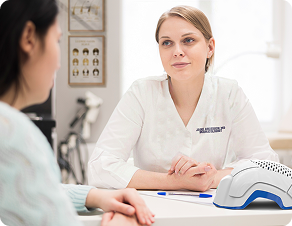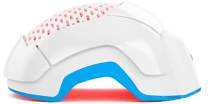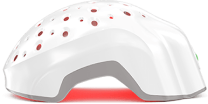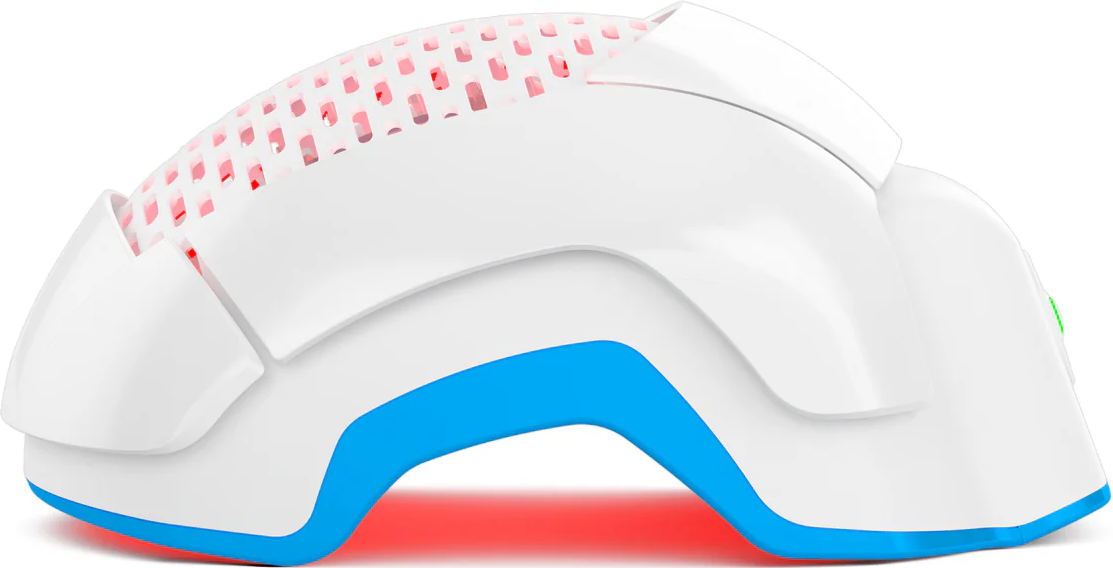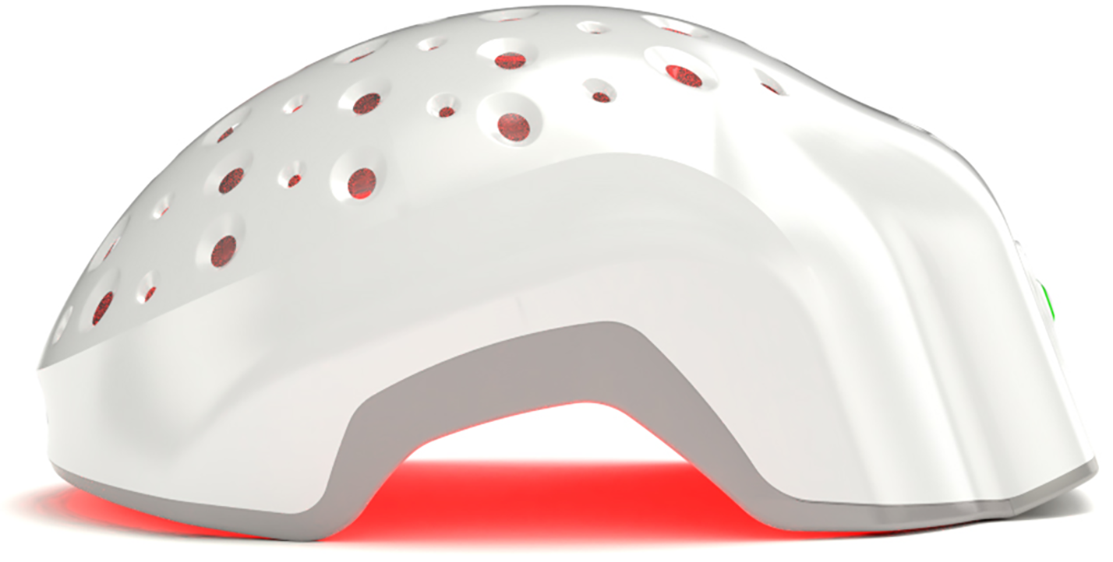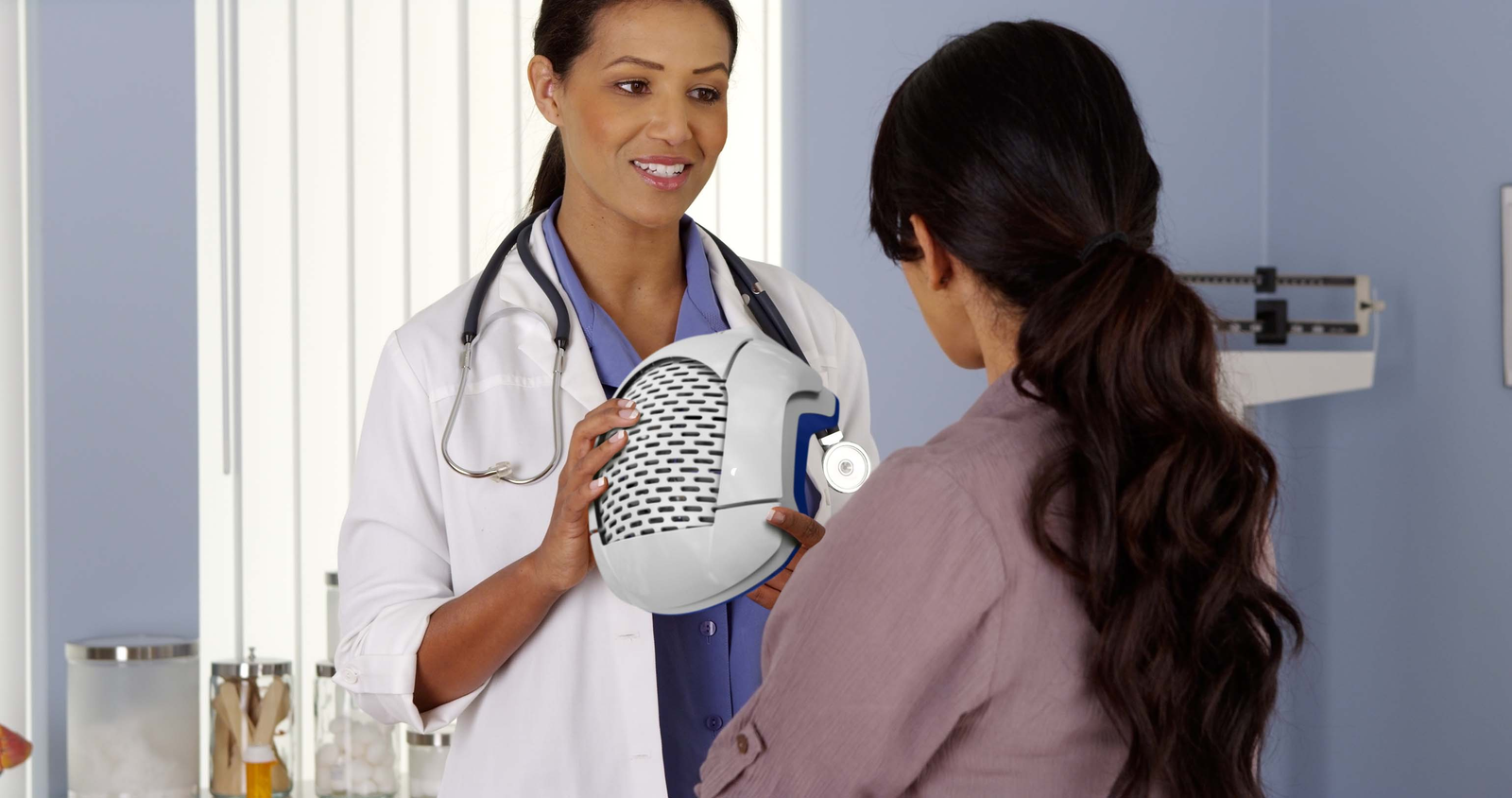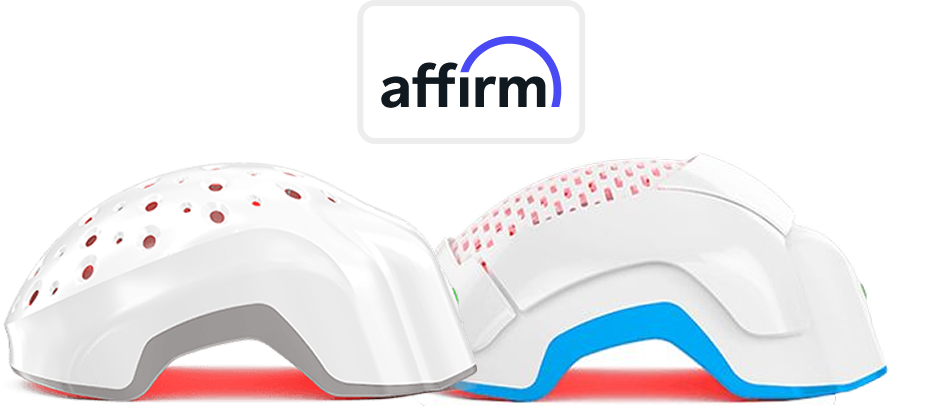Laser Phototherapy (LPT) has emerged as a groundbreaking method to combat hair loss and promote hair regrowth. This innovative technology uses specific wavelengths of red light to stimulate hair follicles, leading to increased cellular activity and hair growth.
But how exactly does this process work, and why is it effective?
What is Laser Phototherapy?
LPT employs low-level lasers, also known as cold lasers, which are designed to emit light at specific wavelengths. Among these, the 680 nm wavelength red light is particularly effective for hair growth. While other wavelengths in the red spectrum (630-650 nm) can also stimulate hair growth, they do not penetrate as deeply as the 680 nm wavelength. This limited penetration means these wavelengths are less likely to reach the stem cells located within the hair follicle. Since these stem cells are crucial for initiating new hair growth, only a wavelength like 680 nm, with its deeper penetration, can reliably activate them and ensure effective hair regrowth.
The 680 nm wavelength is the highest level of red light laser approved for at-home use by the FDA. This wavelength's effectiveness can be traced back to the pioneering work of Dr. André Mester in the 1960s. While conducting experiments on the effects of lasers on wound healing, Dr. Mester accidentally discovered that certain wavelengths of red light, particularly around 680 nm, could stimulate hair growth.
His experiments with rats showed that the light not only healed wounds but also regrew hair in areas where it had been lost, laying the foundation for modern Laser Phototherapy (LPT) in hair restoration.
While infrared light can be effective in professional settings, it poses a risk for at-home use because the light becomes invisible to the naked eye, making it difficult to ensure it's landing on the intended area. This invisibility and the potential for misuse or overexposure make it unsuitable for consumer devices, hence it is reserved for professional treatments under controlled conditions.
Using a wavelength of 680 nm allows the light to penetrate deeply into the scalp, reaching the hair follicle base, including the papilla and bulge, which reside 3-5 mm beneath the skin surface. This depth is crucial for effective hair growth stimulation. Our device utilizes 100% of its lasers in the 680 nm range, with a consistent energy output of 5mW for a full 20-minute treatment, ensuring optimal results.
Additionally, it's important to manage the heat generated by these lasers. Without proper ventilation, lasers can overheat, which is why some devices limit treatment time by pulsing the lasers on and off. However, the best therapeutic treatment involves 20 minutes of uninterrupted use. Our device incorporates ventilation to maintain a temperature close to normal body temperature, ensuring safe and effective treatment without overheating.
But here’s where it gets interesting. Not all lasers are the same. Hot lasers, used in surgeries, generate intense heat capable of cutting through tissue. They are effective for surgical precision and are for use by professionals.
How LPT Stops Hair Loss
LPT isn't just about shining lights on your scalp and hoping for the best. It's a precise, scientifically-backed method that tackles hair loss at the cellular level.
Here's how it works.
1. Stimulating Cellular Activity
The heart of LPT's effectiveness is its ability to stimulate cellular activity. When low-level laser therapy for hair loss is applied, it delivers specific wavelengths of light directly to the scalp. This light energy penetrates the skin and is absorbed by the cells within the hair follicles. But what happens next is what really matters.
The absorbed light boosts mitochondrial function. Mitochondria, often dubbed the powerhouses of the cell, are responsible for producing ATP (adenosine triphosphate), the primary energy carrier in cells. Increased ATP production means more energy for cellular processes, effectively turbocharging the cells' ability to repair and regenerate. This uptick in cellular activity helps shift hair follicles from the dormant (telogen) phase back into the active growth (anagen) phase.
2. Improving Blood Flow
The light from LPT does wonders by boosting circulation to your scalp. When your scalp enjoys better blood flow, your hair follicles get a steady supply of essential nutrients and oxygen, which are crucial for healthy and robust hair growth.
Enhanced blood flow also plays a vital role in flushing out toxins and DHT (dihydrotestosterone), a particular type of testosterone. Both men and women produce DHT, though men typically have higher levels. DHT is notorious in hair loss circles—it binds to hair follicles, causing them to shrink and eventually stop producing hair. DHT is more like a relentless hair-follicle assassin. Once the scalp becomes irritated, DHT attacks and destroys hair follicles, leading to hair loss.
Currently, there are no treatments that can effectively stop or lower DHT levels without significant side effects. However, by improving circulation, LPT helps create a more conducive environment for hair growth, reducing the impact of DHT on the scalp. While it doesn’t eliminate DHT, LPT can support healthier hair follicles, making them more resilient against DHT’s effects.
Low-level laser therapy for hair loss has been shown to significantly increase blood flow to the treated areas. This improved circulation not only supports existing hair follicles but can also revive dormant ones. This is why many users report not just a halt in hair loss but also noticeable regrowth.
Home laser treatment for hair loss makes these benefits accessible without the need for costly and time-consuming clinic visits. With a high-quality, FDA-cleared device, you can boost your scalp’s blood flow right from your couch, ensuring your hair gets the TLC it needs to stay healthy and vibrant.
And let’s not forget, better blood flow isn’t just good for your hair. It can improve the overall health of your scalp, reducing issues like dandruff and itchiness. So, in addition to stopping hair loss, LPT can leave your scalp feeling fresh and rejuvenated.
3. Reducing Inflammation
Inflammation around hair follicles can stunt hair growth and even accelerate hair loss, creating a hostile environment for those precious strands.
But LPT helps reduce inflammation in a way that’s both effective and non-invasive. When you use LPT devices, they emit light at a specific wavelength that penetrates the scalp. This light energy is absorbed by the cells in your hair follicles, promoting beneficial cellular activities. One of the critical outcomes of this process is the reduction of inflammation.
Why is Reducing Inflammation So Important?
Inflammation can significantly impact hair health by reducing blood flow to the hair follicles, depriving them of the oxygen and nutrients they need to thrive. One common cause of scalp inflammation is the overgrowth of Malassezia furfur, a natural yeast organism present on everyone’s scalp. When left unchecked, Malassezia furfur can lead to dandruff and exacerbate hair loss.
Additionally, inflammation can lead to the overproduction of harmful molecules called free radicals, which can damage the cells within the hair follicles. By reducing inflammation, LPT helps mitigate these effects, restoring a healthier environment for hair follicles. This allows the follicles to recover and start producing hair again, reducing the impact of both inflammation and Malassezia furfur overgrowth on hair health.
How LPT Promotes Hair Regrowth
Laser Phototherapy (LPT) doesn’t just stop hair loss—it actively promotes hair regrowth, turning your scalp into fertile ground for new hair.
One of the primary ways LPT promotes hair regrowth is by extending the anagen phase of the hair growth cycle. This is the phase where your hair is actively growing, and the longer this phase lasts, the better for your hair density and thickness.
Extending the Anagen Phase
LPT works by delivering targeted light energy to the scalp, which penetrates the skin and stimulates the hair follicles. This process boosts cellular activity within the follicles and enhances blood circulation, providing the necessary nutrients and oxygen that hair needs to grow. LPT can kick follicles into the anagen phase, the active growth phase, and if the follicles are already in anagen, it can extend this phase. Typically, about 80% of your hair follicles are in the anagen phase, and 20% are in the telogen (shedding) phase at any given time.
By increasing the duration of the anagen phase, LPT allows hair to grow longer and thicker before entering the shedding phase (telogen). This dual action of initiating and prolonging the growth phase results in overall improved hair density and health.
But how does this happen, and why is it so effective?
Cellular Stimulation
LPT’s effectiveness in extending the anagen phase comes from its ability to stimulate cellular activity deep into the scalp 3-5mm where the stem cells reside. That’s the power of 680nm red light laser.
It can reach the right part of the follicle that will grow hair. The light energy absorbed by the hair follicles enhances mitochondrial function, which in turn increases ATP production. ATP, or adenosine triphosphate, is the energy currency of cells. More ATP means more energy for the hair follicles to grow hair.
Furthermore, LPT improves blood flow to the scalp. Better circulation ensures that hair follicles receive ample nutrients and oxygen, essential for healthy hair growth. This dual action—boosting cellular energy and enhancing nutrient delivery—creates an optimal environment for hair growth.
Activating Dormant Follicles
One of the most fascinating aspects of Laser Phototherapy (LPT): its ability to wake up those dormant hair follicles.
Some hair follicles go dormant and stop producing hair. LPT can give them a gentle nudge, or more scientifically, stimulate them back into action.
LPT uses low-level lasers to deliver light energy directly to your scalp. This light energy gets absorbed by the cells within your hair follicles, particularly targeting the mitochondria. By boosting mitochondrial activity, LPT increases the production of ATP (adenosine triphosphate), essentially fueling your hair follicles to shift from the resting phase (telogen) back to the active growth phase (anagen).
Increasing Hair Density
Regular LPT treatment has been scientifically proven to significantly increase hair density, making it a top choice for those seeking fuller hair.
A clinical study published in the National Library of Medicine found remarkable improvements in hair count and thickness among participants using LPT devices. This is hard science supporting the efficacy of LPT.
But why is LPT so effective?
The secret to LPT’s effectiveness is its ability to penetrate the scalp (one of the thickest skins in the body) and stimulate hair follicles at a cellular level. By enhancing cellular activity and improving blood flow, LPT revitalizes dormant hair follicles and extends the growth phase of the hair cycle. This process not only stops hair loss but also promotes the regrowth of thicker, healthier hair.
To achieve the best results for hair regrowth, it is crucial to use an LPT device with the ideal wavelength. Devices emitting light at 680 nm have been shown to yield optimal results, as this wavelength penetrates deeply into the scalp to effectively stimulate hair follicles. When looking for an LPT device, ensure it operates at this specific wavelength to maximize hair regrowth benefits.
Also Read: Is Laser Phototherapy the Ultimate Biohack for Hair Loss?
But Why Not Just Sunshine?
Sunshine is great for beach days and vitamin D, but when it comes to stopping hair loss and regrowing hair, it falls short. LPT offers controlled, consistent, and scientifically-backed benefits that natural sunlight simply can’t match.
Consistency is Key
Sunlight is unpredictable. Its intensity varies with the time of day, weather conditions, and geographical location. In contrast, LPT provides a consistent wavelength and intensity of light. This controlled delivery is crucial for stimulating hair follicles effectively. According to studies, the specific wavelength used in LPT penetrates the scalp to boost cellular activity and promote hair growth without the variability of natural sunlight.
Natural sunlight contains a mix of wavelengths, including harmful UV rays that can damage your skin and hair. LPT devices, however, emit light at specific wavelengths that target hair follicles without the risks associated with UV exposure. This precise control is why laser therapy results for hair loss are more reliable and effective compared to simply soaking up the sun.
Let’s be honest—relying on sunlight alone to support hair growth is impractical. While vitamin D, which you can get from sunlight, helps support hair health, it isn't sufficient for regrowing hair. LPT offers controlled, consistent, and scientifically-backed benefits that natural sunlight simply can’t match. LPT provides the specific wavelength (680 nm) needed to penetrate the scalp and stimulate hair follicles effectively without the variability and risks associated with prolonged sun exposure. Overexposure can lead to a sunburned scalp, which can cause hair loss.
The Importance of Proper Dosage and Device
While LPT is highly effective, it is crucial to use the right device and follow the recommended treatment protocols.
Here are some key factors to consider:
Wavelength
The optimal wavelength for LPT is 680 nm, which is the most powerful laser on the market for at-home use. This wavelength is particularly effective in stimulating hair follicles without causing heat damage, ensuring both safety and efficacy.
Treatment Duration
According to the Swedish Medical Society, which has been testing laser dosage and optimal durations for stimulating tissue since 1976, a full twenty minutes is necessary for the ideal dosage. The claim that effective results can be achieved in as little as ninety seconds or up to just six minutes daily is simply untrue—one among several myths.
For lasers to be effectively absorbed by the scalp, and depending on factors like wavelength, beam diameter, energy delivered per square centimeter, and distance, the process takes twenty minutes. Consistent use over several months is necessary to see significant results.
Device Quality
It is essential to use FDA-cleared laser hair growth devices to ensure safety and efficacy.
The best laser hair growth devices are designed to deliver consistent light energy without overheating, which is critical for preventing scalp damage. FDA clearance indicates that the device has been reviewed and deemed safe and effective for its intended use. If you want to learn more about laser phototherapy, read our best-selling hair book "Grow It Back".
